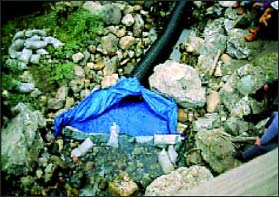|
Forest Road Deactivation Practices
|
|
in the Pacific Northwest
|


|
|
| 8 - Dewatering Stream Channels
|
Detailed Work Plan, Useful Hints |
Dewatering streams is effective when removing culverts outside the fisheries windows, or in streams that present a high risk of sedimentation.
Water can be pumped around the site with volume pumps, moved to
below the working area by a gravity system or diverted away from the
site in a temporary channel. Poorly planned and executed diversions can
cause serious impacts on water quality and fish habitat, and can cause
major erosion if "water is simply directed down the ditch for awhile ...".
Supervisors and operators should prepare a detailed work plan and assemble all required tools and materials before work begins.
Diversion/Dewatering Work Plan
Develop and follow a step-by-step plan with the following points:
- Fish: isolate work site and remove fish from isolated section.
- Install downstream failsafe dam if deemed necessary.
- Install upstream diversion/dewatering works and initiate action.
- Complete planned instream deactivation work.
- Disassemble upstream works.
- Disassemble downstream works.

- Fish Removal is required before instream work begins. If the deactivation takes a full day, removal should take place the day before. Check with the agencies about timing of fish migration in the stream. The time period of the stream blockage should be minimized. Allow for fish passage if the project extends over several days.
- Building a Downstream Dam: the primary use of this structure is to catch minor sediment or suspended particles in the water. It also provides a level of comfort for unforeseen circumstances.
- Building an Upstream Dam: an effective dam is critical in any flow diversion as it must capture all the water flow. If you use a "pumparound", have a sufficient number of pumps (spares) and gas. Avoid using pumps if you can't complete the job in one shift.
- Complete the Instream Work as planned. Have ready and on site the water manager's tool kit to deal with the unexpected.
- Disassemble Upstream Dam but try to keep the dewater/diversion going as long as possible to facilitate the disassembly, and to minimize the release of a surge flow. Maintain the downstream works while the flows increase into the isolated stream section.
- Disassemble Downstream Dam only when water quality returns to normal levels. Remove the fish blockages and all materials and restore the site to its original state. Take pictures of the deactivated site for future inspections.
| 8 - Dewatering Stream Channels
|
Dewatering Streams 8 
|
|
©1999 - 2002 Flip Productions Limited
Used with permission by CulvertBC
|
